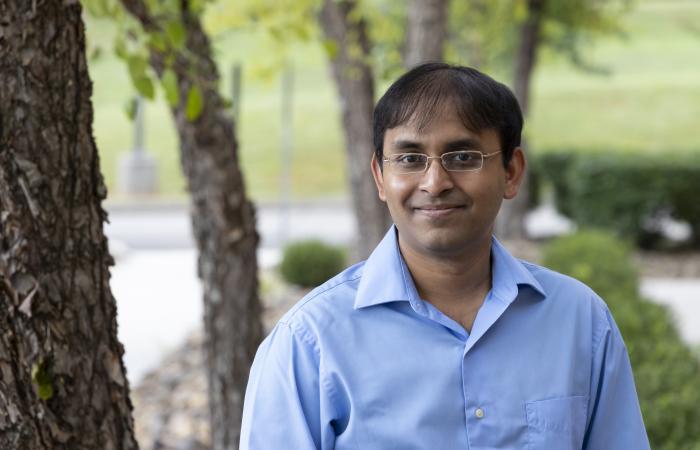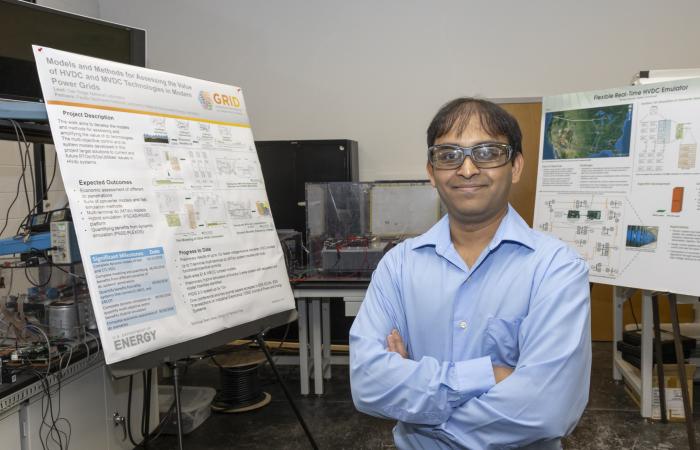-

Suman Debnath is using simulation algorithms to accelerate understanding of the modern power grid and enhance its reliability and resilience. Credit: Carlos Jones/ORNL, U.S. Dept. of Energy
-

Suman Debnath is using simulation algorithms to accelerate understanding of the modern power grid and enhance its reliability and resilience. Credit: Carlos Jones/ORNL, U.S. Dept. of Energy
-

Suman Debnath is using simulation algorithms to accelerate understanding of the modern power grid and enhance its reliability and resilience. Credit: Carlos Jones/ORNL, U.S. Dept. of Energy
-

Suman Debnath is using simulation algorithms to accelerate understanding of the modern power grid and enhance its reliability and resilience. Credit: Carlos Jones/ORNL, U.S. Dept. of Energy
Planning for a digitized, sustainable smart power grid is a challenge to which Suman Debnath is using not only his own applied mathematics expertise, but also the wider communal knowledge made possible by his revival of a local chapter of the IEEE professional society.
The foundational switch from an analog grid supplied by large, centralized power plants to a digitized system made up of intermittent renewable and distributed energy sources supported by power electronics brings both benefits and challenges, said Debnath, a researcher in ORNL's Power Electronics Systems Integration Group.
Digitization accommodates sustainable energy sources like solar and wind, advanced energy storage and loads such as electric vehicle charging and smart appliances. These changes to the grid mean electricity no longer flows in a single direction, but is multi-directional and must transform quickly and smoothly between direct-current, or DC, and alternating-current, or AC systems - hence the need for power inverters and converters based on advanced power electronics.
"A digitized grid also results in a more intelligent system with the ability to automate controls compared to legacy systems, all of which can result in greater reliability," Debnath added.
Debnath and his colleagues are modeling how the grid performs using high-fidelity, physics-based models, and employing that information to design and develop advanced power electronics with computational intelligence that can rapidly respond to grid needs. Smart inverters driven by advanced power electronics can, for instance, increase or decrease power output from solar and wind sources instantaneously, using energy storage to stabilize the grid - essentially replacing inertia supplied by heavy rotating equipment at large, conventional power plants.
Underpinnings for a resilient smart grid
As Debnath's work accelerates, he and fellow researchers are inventing a system that doesn't just follow the needs of the existing power grid, but actually creates a new kind of grid. The goal is a modern system that can support 100% reliance on sustainable energy.
Debnath's research focuses on the development of next-generation algorithms that speed simulations of power electronics-dominated grids and accurately characterize their dynamics. His projects include simulation algorithms to enhance our understanding of photovoltaic, or PV, systems and their function within the larger grid. In another project, he is developing next-generation integration methods based on power electronics to efficiently control large solar farms with onsite energy storage and connect these resources to DC-AC systems. He is also modeling the grid impacts of extreme fast charging systems for electric vehicles using advanced simulation algorithms, including 1-megawatt-level advanced chargers, work which Debnath calls grid "delivery planning."
Debnath likewise keeps a hand on the experimental side, using his modeling work to help design next-generation hardware and controls for the grid.
Growing up in India the son of a mechanical engineer, Debnath went on to earn his undergraduate and master's degrees in electrical engineering at the India Institute of Technology in Madras. While pursuing his doctorate in electrical and computer engineering at Purdue University, he worked on applied math for power electronics and the power grid, focused on wind energy systems integration. But he was also interested in wireless power transfer, and it was ORNL's work in wireless charging that first attracted his attention.
"Wireless power transfer was a completely new thing back then, not many people knew about it," Debnath said. "So, it was the novelty of early-stage research, as well as the possibility of continuing my grid integration work, that drove me to apply for a postdoctoral position at ORNL about six years ago."
During his time at ORNL, the lab's power electronics researchers demonstrated the world's first 20- kilowatt bi-directional wireless power transfer system between a light-duty vehicle and a battery pack. The technology has since been scaled up to a 120-kilowatt demonstration, and the wireless charging system was installed on a UPS medium-duty delivery truck.
Getting outside your comfort zone
Debnath enjoys the diversity of basic science and applications work going on at ORNL and notes that much of it can be applied to his own research. "I get insights from material physics, from artificial intelligence work - these all have a basis in math. It's important to bring in new ideas for successful research," he said.
Debnath has encouraged collegial thinking by leading a regional professional group - the IEEE East Tennessee Section Power & Energy Society/Power Electronics Society Joint Chapter - since 2017. The joint chapter hosted popular in-person lectures in the Oak Ridge/Knoxville area for about three years before the pandemic, and now that they've gone virtual, the talks are drawing an even larger audience. Speakers for the virtual sessions come from the United States and Europe, representing industry, academia, private research organizations and national labs. The joint chapter now has about 15 all-volunteer members on its executive committee and has been recognized by IEEE as a top performer.
"Hearing about diverse applications and attitudes is important. When you get out of your comfort zone, that's when you learn. We've tried to create a platform where people can share their work and thought processes, and we've had great feedback," Debnath said. "We sometimes call it techno-tainment, and it resounds with a lot of engineers who want to expand their knowledge."
In addition to work funded by the Department of Energy, Debnath acknowledges the importance of ORNL's lab-directed research and development program to his research. "With the LDRD program, I've had the opportunity to develop my early-stage research ideas and put my thoughts into action. It's one of the things that's been extremely important to helping me develop as a research professional," he said.






